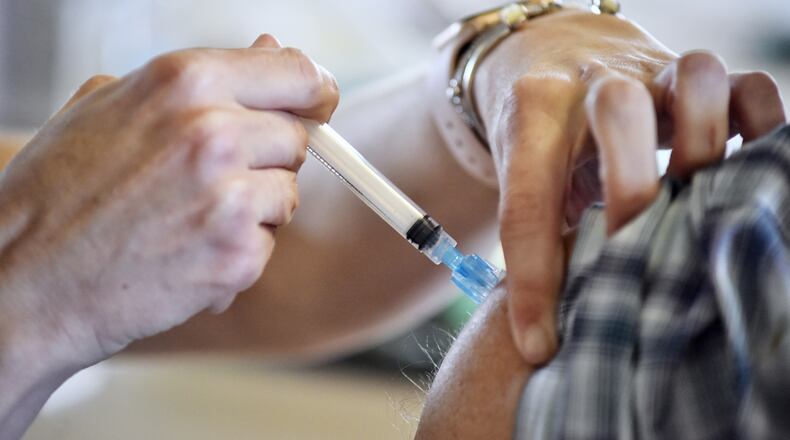Thursday marked the fifth straight week cases decreased in the state.
Montgomery County is also experiencing this downward trend. As of the week ending Oct. 5, the two-week incident case rate decreased from 211.4 per 100,000 last week to 180.7 per 100,000 this week, according to Public Health - Dayton and Montgomery County (PHDMC).
With the exception of Butler County, the rest of the Dayton-region is also on the CDC’s low COVID-19 transmission level.
Health officials are continuing to recommend getting vaccinated and staying home when sick to keep the transmission level low. Potential surges in the future are still unknown.
“We don’t know what the future will hold in terms on different strains of the virus,” said Dan Suffoletto, PHDMC public information manager.
PHDMC is also continuing to see interest in the new COVID-19 boosters. The department recommends individuals keep up to date on their vaccinations by getting either their initial dose or a booster shot.
“We’re seeing interest in the new boosters, and we’re also continuing to see new people get the vaccine for the first time,” Suffoletto said. “It’s very important to get whatever vaccine is available at the time.”
More than 7.48 million Ohioans — approximately 64% of the state’s population — has received at least one dose of the COVID vaccine and 59.3% of Ohioans have finished it.
About 3.81 million people in the state have received their first booster shot, and 1 million have received a second booster.
Since Sept. 1, nearly 457.500 people have received the updated booster dose, which health officials say offers better protection to current COVID variants. In the past week, 131,987 people got the updated booster, according to ODH.
Health officials are also recommending the community to get vaccinated against the flu, saying it is safe to get both the flu and COVID-19 boosters at the same time.
When a county is designated at a low level in the community framework, the CDC recommends following actions:
- Stay up to date on vaccination, including recommended booster doses.
- Maintain ventilation improvements.
- Avoid contact with people who have suspected or confirmed COVID-19.
- Follow recommendations for isolation if you have suspected or confirmed COVID-19.
- Follow the recommendations for what to do if you are exposed to someone with COVID-19.
- If you are at high risk of getting very sick, talk with a healthcare provider about additional prevention actions.
- If you are immunocompromised or at high risk for severe disease, learn more about how to protect yourself with additional CDC recommendations for each COVID-19 Community Level.
Hospital admissions were also down in the past week. Ohio reported 369 weekly hospitalizations Thursday compared to 432 the previous week.
On Thursday, there were 774 hospitalized patients with COVID in Ohio, including 51 in west central Ohio and 109 in southwest Ohio, according to the Ohio Hospital Association.
For southwest Ohio — which includes Butler, Warren, Hamilton, Adams, Brown, Clermont and Clinton counties — it’s a 3% decrease from last week and a 44% decrease from 60 days ago.
West central Ohio — which is made up of Champaign, Clark, Darke, Greene, Miami, Montgomery, Preble and Shelby counties — reported an 11% decrease in coronavirus inpatients from a week ago and a 63% decrease compared to 60 days ago, according to OHA.
As for the state’s ICUs, there were 111 inpatients with COVID statewide as of Thursday, including 19 in southwest Ohio and five in west central Ohio.
Southwest Ohio had a 12% increase in ICU patients with the virus compared to last week, but saw a 34% decrease from 60 days ago.
There was a 50% decrease in COVID patients in west central Ohio’s ICUS in the past week and a 62% decrease compared to 60 days ago, according to OHA.
Ohio added 27 weekly ICU admissions Thursday, according to ODH. It was up from 22 coronavirus ICU admissions reported the previous week.
The state also recorded 94 COVID deaths in the past week, bringing Ohio’s total to 39.950, according to ODH.

